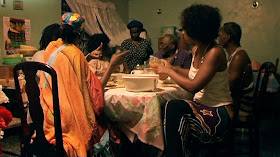TrustMovies has long felt that cinema has rarely, barely ever, shown off that most unusual performer/singer Grace Jones to good advantage. Of her three major movies -- the second-rate Bond film, A View to a Kill; a lesser Eddie Murphy vehicle, Boomerang; and the surprisingly entertaining vampire movie, Vamp -- only in the latter did the filmmakers put this strong and visually striking woman to anything approaching maximum use.
Now, in the new documentary, GRACE JONES: BLOODLIGHT AND BAMI, filmmaker Sophie Fiennes (of The Pervert's Guide to Cinema and Over Your Cities Grass Will Grow) manages to do this larger-than-life presence cinematic justice -- and then some.
Ms Fiennes, shown at left, seems to have been given remarkable access to Jones, her family, friends and co-workers -- and over a period of several years, at that -- and although the filmmaker does not identify time frames, or even places, her documentary provides a surprisingly good entryway into the life and times, as well as the music and performing abilites of this remarkable woman. Ms Jones turns 70 next month, but you would hardly know it watching and hearing her sing, prance, move and command whatever stage she is on.
As a young man, I found myself in awe but also somewhat frightened of this incredibly statuesque and sexual icon. With age and a better understanding and appreciation of who Jones is and what she is doing, I am now a major fan. You may be, too, once you've spent the nearly two hours of time that Fiennes, as both director and editor, has cobbled together in such a free-form but oddly gripping fashion.
There is no way around the fact that this entertainer cuts such as formidable figure -- the lithe/lean body, the bizarre head-gear, and those endless legs! The movie begins and spends a good deal of time in a musical number or two, and then lets us see her adoring fans, with whom she interacts The music we hear seems more impressive than I remember from decades past. But, then, perhaps my tastes have changed for the better over the years.
Fiennes spends a good deal of time with Jones' family -- mother, siblings, kids, even I think, a grandchild -- and almost as much behind the scenes as she works to bring about another concert. There's a little of her love life, too. And even some casual, full-frontal nudity (yes, she looks justs as fabulous unclothed).
She goes to church, where we hear (I think it's her mom singing) His Eye Is on the Sparrow. Later the preacher fills us in on Jones' history as a naughty little girl. Along the way, we get snippets of her philosophy: "Sometimes you have to be a high-flying bitch!" and "Deep love is like a beating with a cloth belt." Family history and her father's death crop up, too.
The documentary ends with the idea of possibly building a house in the hills of Jamaica (where Jones was born) and where an earlier house was destroyed by a hurricane. Set to this is one of her more recent songs, Hurricane, which is an impressive piece of music sung with all the strength and power one might expect of this phenomenon.
Watching the viewing link I was sent, I sometimes wished for English subtitles to help decipher the soundtrack's dialog that was occasionally hampered by too-loud ambient sounds and/or the Jamaican accents. Otherwise, this documentary proved engrossing and impressive -- a "must," I think, for any Jones fan, and a film that will most likely convert a number of newcomers, too.
From Kino Lorber and running 115 minutes, Grace Jones: Bloodlight and Bami opens tomorrow, Friday April 13, in New York City at the Metrograph and Film Society of Lincoln Center and at BAM in Brooklyn. On April 20 it hits Los Angeles at the Landmark NuArt, and then over the weeks to come open in cities all across the country. Click here and scroll down to see the complete list of playdates, cities and theaters.









No comments:
Post a Comment